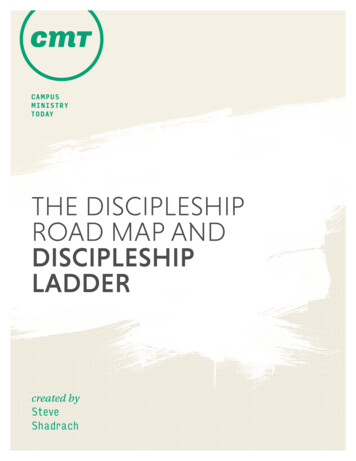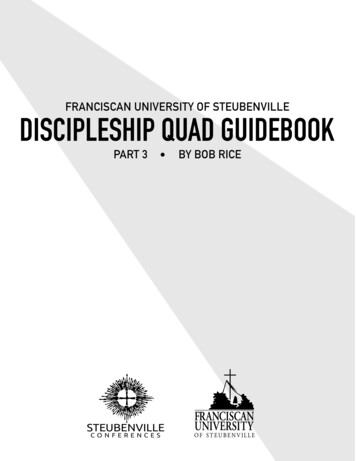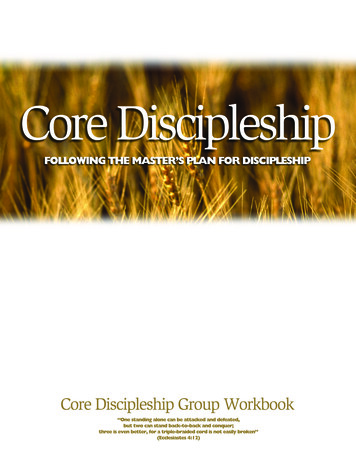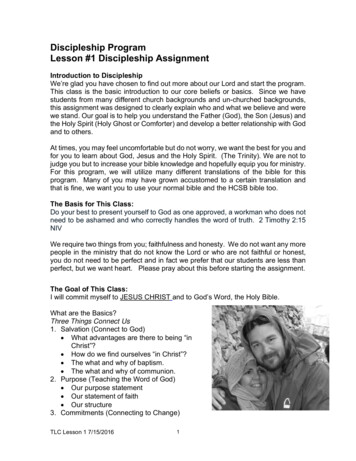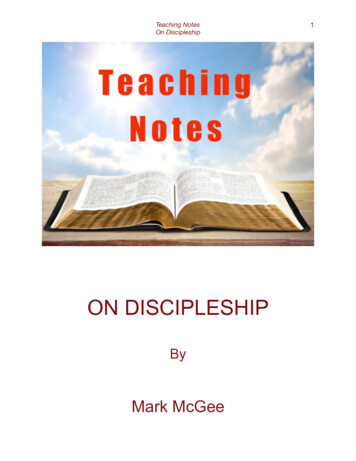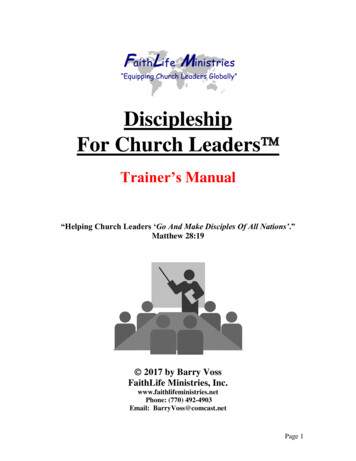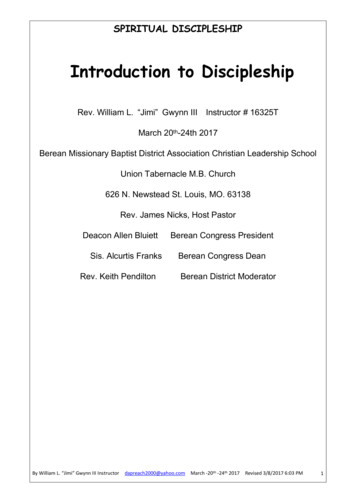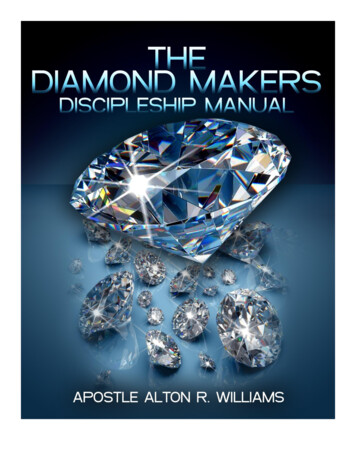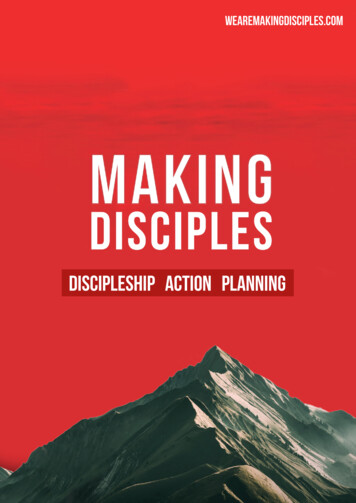
Transcription
Wearemakingdisciples.comDISCIPLESHIP ACTION PLANNING
DISCIPLESHIP ACTION PLANNING:WHOLE LIFE DICIPLESHIPINTRODUCTIONThis document will give you a framework to think through deepening discipleship within yourcommunity. Without deliberate planning we will only end up reaching accidental goals. It’s inthe planning that we are helped to reach the goals we see before us. Action planning is like anarrow; It points us in the right direction towards the end goal we are aiming for. We may notget there or we might over shoot, but at least we are pointing ourselves towards thedestination. Action planning also helps us to evaluate and then re-evaluate how well we aredoing in attaining this goal. Planning is a process and communicates our intentions. Makingdisciples is a clear intention in the gospels so must be our clear intention too.The clear intention is the great commission set out in Matt 28 as, “Go make Disciples,baptising them in the name of the Father, Son and Holy Spirit”.With so many other pulls on our time and ministry if we don't set some goals we will neverlive out this clear calling for every leader, church and member. By clearly articulating our goalsand indicating the steps for disciple making we make plans to achieve them, we createintentional discipleship points and dream up new plans and rework old ones.HOW TO WRITE A DISCIPLESHIP ACTION PLANThis document will help you review the width of discipleship, assess what you are alreadydoing, work on the gaps, see what needs developing and what needs cutting. Within thisdocument you will find a ‘Discipleship Chart’ outlining the work of discipling someone, a toolto take an audit of present activity and a tool to help shape an action plan for the future.THIS IS THE GOALDiscipleship is the ‘whole life commitment’ to seeing Jesus transform the ‘whole of our lives’.Biblical Discipleship is surrendering one’s HEAD, HANDS and HEART to the will and call ofChrist. The way we mature in this call is to allow ourselves to be ‘connecting’ in relationshipwith God and the wider Church, continue to grow in ‘understanding’ of who Jesus is and Histeaching, be ‘equipped’ in the ministry given to each one through the Spirit and then ‘serve’God, the church and the world with this gifting.
STEP ONE:If you have not already visit WEAREMAKINGDISCIPLES.COM and access theDiscipleship shape tool. Using this tool with your whole church you will be able toascertain the discipleship needs of your congregation. The Discipleship tool helps plotthe congregation’s health along 20 dimensions, under the 3 themes of Head, Handsand Heart.The following chart aims to articulate the whole life shape of a disciple in these 3dynamics of HEAD, HANDS and HEART.HEADHANDSHEARTKnowing, thinking and understanding Contributing, creating, leading andConnecting, loving, appreciating andwho Jesus is and his teachings andequipping in the gifts and skills of thebelonging personally with God and aallowing them to transform belief and Kingdom and serving by participation in Jesus community and allowing the heartattitudes.God’s mission and activity in the world.to be transformed.A growing disciple of Jesus will bedeepening their understanding of whoGod the Father, Son and Holy Spirit arethrough a developing Bible knowledgeand through community conversation.Be able to articulate and explain God’splan of salvation and their role within it.A growing disciple of Jesus will bediscovering spiritual gifts and their partin using them as a tool kit for a Jesusway of life.A growing disciple of Jesus will bedeveloping a personal journey as well ascommunal one in terms of spiritualformation.Be growing in the awareness of howthese spiritual gifts are to be used tobuild up the church as well as a call topersonal mission and ministry.Be growing and deepening a livingrelationship with God.Be developing an understanding of therole of the church in God’s mission; be Be living in such a way that this Jesusobedient to God’s call to a Christian life way of life is contagious to others.and the act of being a living sacrifice.A growing disciple of Jesus will beBe maturing in the Biblical narrative and actively looking for opportunities toteachings of the whole church aroundserve and minister to others in naturalthe fall, salvation, redemption and theand normal ways especially the last, themission of Jesus.least and the lost.Be deepening in their knowledge of thebigger God story and its impact on thelocal community.Being shaped in a loving Jesus family,developing positive and supportiveChristian relationships.Be developing in a devotional life ofprayer and intersession.Be able to apply sound Biblicalteachings to discern direction and makedecisions that harmonise with beliefs,values and practices.Be maturing in sharing their personaltestimony of God’s grace withBe maturing in relationship andcommunity members, friend’s family and fellowship with others.co-workers.Being shaped in their thinking by thisBe allowing areas of sin and brokennessstory affecting all areas of their life.Be investing themselves into discipling be challenged and restored.others.Be challenged by those not like them toBe open and honest about strugglesthink differently and be shaped by theBe supporting and equipping ministries with a close group who can encouragewider church thinking.in the local and global church.healthy living.Be resourcing the church with finance,time and prayer.Be shaped by the call to be the hands,feet and mind of Christ in the world.Be willing to accept Jesus’ call to servethe servant church through His giftingand supporting.
STEP TWO:WHAT DOES THIS LOOK LIKE AT PRESENT IN THE LOCAL CHURCH?Within any church community there has to be a buffet of resources for discipling and forming an individual. Weneed to have places to teach, correct, model and serve. Sadly many of our churches have been doing the samething for so long we think it's the best way to do what we do. If we want to change the outcome of our workthen we need to change what we do and how we do it. Doing the same old things will only yield the sameresults. Taking an audit will help us see what is happening and how effective the results are. It is also paramountthat we move away from ‘this is how our tradition or denomination do it’. All Christian denominations andtraditions have things for us to learn from. When a church is able to look to the other traditions to see the uniqueattributes and recourses we can learn from the wider body.These activities of discipling could involve . Sunday activity or the sermonServing on a ministry teamSmall groups, lent courses, regular theology groups or book groupsMission teams or serving on a mission programLeadership development programsPrayer triplets or groupsOne to one mentoring, spiritual direction or regular pastoral supportConference or spiritual retreatsTake some time to list and define all your church activities. Then score them on a scale of 1-5, 1 beinglow and 5 being high according to the Impact of the Activity and the Level of Effort required to run it.Doing this activity audit will help understand what’s working well right now and how much work itrequires.ACTIVITYList here all the activitiesfrom your ChurchExample: Church hopscotch clubExample: Sunday morningserviceExample: Sunday evening serviceExample: Morning PrayerExample: Mentoring ProgramExample: Lent courseExample: Football outreachExample: Lunch clubExample: Study groupsExample: Evangelism courseESSENITAL IMPACT OF ACTIVITYLEVEL OF EFFORT TO RUNHandsHeadHeartTotalStaff time14385VolunteerTime4Total9
ESSENTIAL IMPACT AUDITACTIVITYList here all the activities fromyour Church Community. Be ascomprehensive as possible.ESSENITAL IMPACT OF ACTIVITYHandsHeadHeartTotalLEVEL OF EFFORT TO RUNStaff timeVolunteerTimeTotal
STEP THREE:DISCIPLESHIP IMPACTSadly we can be doing a lot but not achieving what we think we are achieving nor making theimpact we wish. Some of what we do is high maintenance and low impact, in other words ittakes a great deal of time, effort and maybe money to put on, but doesn’t achieve a greatdeal; and of course there is the opposite too, somethings are high impact and low tomaintain. Then there are all the things in-between.By reviewing all our activities we are able to look at the church as a whole and see whetherwe are providing opportunities to make disciples. Obviously, some things are hard work andhigh maintenance but when we assess it we decide they are worthwhile although of coursethere may be ways that these activities can be optimised for even greater affect. Some thingsmight need to be paused for a season or even stopped to make space for new ideas andinitiatives. Some things are necessary but could these be changed in some way to inviteothers into the process for the purposes of discipleship?Take your scores from step 2 and place your activities on the following chart. This gives us avisual image of our activities in terms of maintenance and discipleship. Some things might below maintenance and very high impact, these are the perfect activity we want. This auditshould help you see review your activities and then try to optimise (i.e. make easier) the highimpact, high effort things, ignore the low impact, low effort activities and prioritise and learnfrom the high impact, low effort activities.Impact Audit Example.
STEP FOUR:
STEP FOUR:REVIEWIn this step, we compare the Discipleship Impact Audit (Step 3) with the whole churchdiscipleship shape. As a church leader you will be able to download this fromwearemakingdisicples.com once your church has completed the Online Assessment Tool. Bycomparing the two you will be able to see if you are having the impact you were expecting.You might find some perceived low impact activity is having a greater impact than you thinkand high impact less of an impact.NOTESWhich areas or questions on yourwhole church assessment arecoming out as low discipleshipareas? Does this match up withyour findings on the DiscipleshipAudit?In what area do you have lowscores on the discipleship tool buthigh impact scores on the activityaudit? What could this be areflection of? Is it linked to people’sstarting points, the length of time ofthe activity, a gap betweenleadership perception and thecongregation’s perception orsomething else? Consider whatcould change to be more effectiveat discipleship.In what areas do you have lowscores on discipleship tool and lowimpact scores on your activityaudit? Reflect on these activitiesand see if there is something youcould change or introduce toaddress this gap.In what areas to you have highscores on discipleship tool and highimpact scores on your activityaudit? Reflect on these activitiesand celebrate their effectivenessand see if there are things you couldadapt for other areas of the tool.ACTION
STEP FIVE:ACTION PLAN HEADQuestions to consider focusing thought on the HEAD area discipleship.WHAT:Do you have the right mix of activities to supportthis area of discipleship?Possible or suggested activities to developcould include What activities could you drop?What could you expand or grow?HOW:What aspect of the church culture helps orhinders this discipleship dimension?How could improved HEAD be embedded inall church life?WHO:Who are the real champions of HEAD within thechurch?People to develop in this area of leadership?How could they be used or inspired to spreadexcitement and passion for HEAD through thecongregation?
ACTION PLAN HEARTQuestions to consider focusing thought on the HEART area discipleship.WHAT:Do you have the right mix of activities to supportthis area of discipleship?Possible or suggested activities to developcould include What activities could you drop?What could you expand or grow?HOW:What aspect of the church culture helps orhinders this discipleship dimension?WHO:Who are the real champions of HEART within the People to develop in this area of leadership?church?How could they be used or inspired to spreadexcitement and passion for HEART through thecongregation?How could improved HEART be embedded inall church life?
ACTION PLAN HANDSQuestions to consider focusing thought on the HANDS area discipleship.WHAT:Do you have the right mix of activities to supportthis area of discipleship?Possible or suggested activities to developcould include What activities could you drop?What could you expand or grow?HOW:What aspect of the church culture helps orhinders this discipleship dimension?WHO:Who are the real champions of HANDS within the People to develop in this area of leadership?church?How could they be used or inspired to spreadexcitement and passion for HANDS through thecongregation?How could improved HANDS be embedded inall church life?
FINAL CLEAR ACTION PLANUse this following chart to give you a clear outline for your churches Actions Plan. The moredetail the better, think SMART (Specific, Measurable, Attainable, Realistic, Time bound). Thisis all about being intentional with change. Discipleship does not happen by accident, ithappens because we intentionally put the frame work for growth in place.OBJECTIVEHEADHEARTHANDSWhat do weWhat TASKS dowant to ACTION you need to do toor see happen toachieve thesedevelop in thisgoals? This mayarea.be new projects orways ofdevelopingBy WHEN doyou need tocomplete thetask?WHAT do youneed to completethis taskWHO will dothis?
Discipleship shape tool. Using this tool with your whole church you will be able to ascertain the discipleship needs of your congregation. The Discipleship tool helps plot the congregation’s health along 20 dimensions, under the 3 themes of Head, Hands and Heart. The following chart aims to
